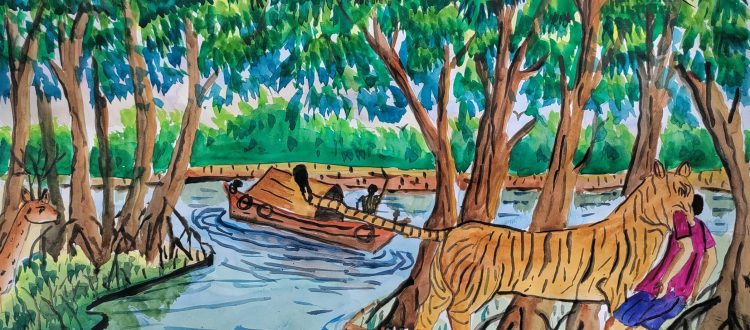A painting from the Sundarbans
If your child was asked to paint a tiger, what would you expect? Like most who have seen the tiger on a TV screen or in a zoo, it would usually be a portrait of the animal in its unique colors. But seldom would your kid come up with something so vividly disturbing as did 12-year-old Subhankar Mondal from Binodpur village in Sundarbans. He painted what he experienced.

Painting by Subhankar Mondal during a WTI event in Binodpur | Photo by Prosenjit Sheel
Subhankar’s family have lived among tigers for generations. As a child, he has seen some friends and neighbors getting killed by the predators. In 2021-22, there were two cases of death in his village and one more person had suffered injuries. But life continues and human-tiger conflict is just another challenge that the villagers have adapted to.
Livelihoods in villages like Binodpur on the fringes of the Sundarban mangroves are completely dependent on the forest. A few people grow their own rice but for the majority, sustenance comes in the form of fishing, crab collection and NTFP products like honey. There is no alternative to firewood either, thus making trips to the forest an integral part of the daily routine. Making it back alive is a matter of luck.

Maa Narayani, Bonobibi, Sahjongli | Photogrph by Samrat Paul/WTI
Every time Subhankar’s father prepares for his trips, sometimes accompanied by his mother, Subhankar prays to Maa Narayani, Bonobibi and Sahjongli, the revered deities of the forest. His prayers have worked but it hasn’t been the same for everyone. For Sukanta Naiya, a student in fifth grade, his drawing was a living nightmare.
This is not how life should be.
Wildlife Trust of India, in collaboration with the West Bengal forest department has been working to provide a secure and safe alternative livelihood to families like Subhankar’s. Nearly 600 families will soon have improved low-emission cook stoves that would reduce the amount of fuelwood collection and minimize the trips to the wilderness. Further, a nylon fencing around the village boundary has been able to keep tigers that move out of the forests from entering human dominated habitats.
Tigers of Sundarbans enjoy a special status. Adapted to the mangroves, they are unique in their ability to walk and hunt on the muddy terrain and constantly swim the channels to move between islands. These tigers have played the muse of both God and Ghost and inspired both folklores and nightmares. Along with the saltwater crocodiles that thrive in the ecosystem of Sundarbans, the tigers have been revered as Demi-Gods that protect the forest.
Over the past decade, tiger numbers have increased but the cases of Human-tiger conflicts have gone down. While this is conflicting, it can be well reasoned by the increased awareness among locals and mitigation measures taken up by the local administration and NGOs. Along with mitigation measures, WTI regularly conducts outreach programs that would soon be supported by Sundarban Education Centers (SEC).

Villagers fishing in the forest fringes of Binodpur | Photograph by Samrat Paul/WTI
WTI’s Integrated Tiger Habitat Conservation Programme (ITHCP), also trains local volunteers for rapid resolution of conflict cases. These Primary Response Team (PRT) members help in the monitoring, capture (if necessary) and safe release of tigers back in the forest, in case they cross over to human habitation. The aim is to ensure that no child loses his parents and vice-versa.
Let’s change the picture.
The ITHCP is an initiative implemented by the International Union for Conservation of Nature and funded by German Cooperation via KfW Development Bank, which contributes to the global effort to double tiger numbers in the wild by 2022 by supporting landscape level conservation work benefiting species, communities and habitats Coordinated actions enhancing conservation skills developing new livelihoods and improving governance and infrastructure are delivering results in terms of better protected tigers across these landscapes.
Watch Aboshesh – the animated film for communities living with tigers in Sundarbans. Click here to watch!
by Madhumay Mallik









